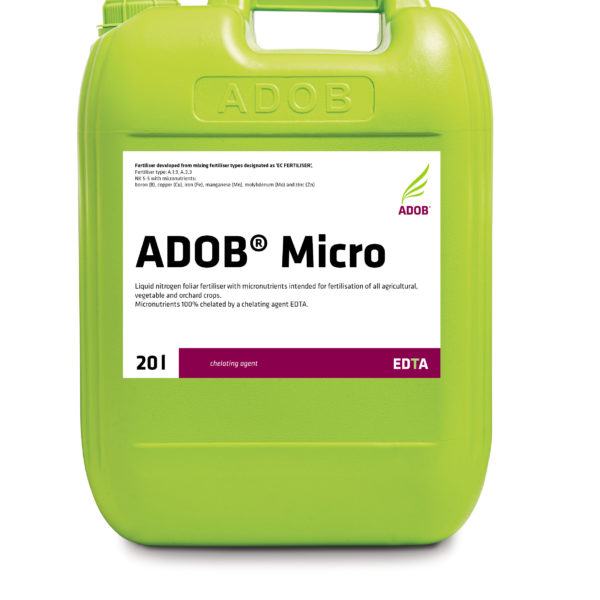Characteristics
ADOB® Micro is a multinutrient, multifunctional liquid fertiliser for the foliar feeding of arable, vegetable, floriculture and orchard crops. It contains basic levels of amide nitrogen and potassium (5% each). All six micronutrients are present, with focus on a very high concentration of manganese (Mn) alongside moderately high concentrations of boron (B), copper (Cu), iron (Fe), molybdenum (Mo) and zinc (Zn).
All micronutrients (except boron and molybdenum) are chelated by the classic EDTA agent, while boron and molybdenum (which cannot be chelated) are present as water-soluble, inorganic components. As a result, all nutrients are readily and quickly available to a broad range of staple and cash-crop plants. This unique combination of essential nutrients ensures the optimal development of plants’ shoots, roots, flowers, fruits and grain yield.
ADOB® Micro also boosts plants’ vigour and health. It improves their winter hardiness and effectively prevents nutrient deficiencies.

Packaging: 10, 20, 1000 l
Features
100% chelation of micronutrients
enhanced development of all plant parts
macro- and micronutrient fertiliser
contains all micronutrients
liquid fertiliser
foliar application
EDTA chelated
CE fertiliser
Download
Scroll left/right to see more
| Nutrients | Symbol | Content [% w/w] | Content [% w/v] | Content [g/l] | Form |
|---|---|---|---|---|---|
| Total nitrogen | N | 6.0 | 7.7 | 77.0 | |
| - nitrate nitrogen | N-NO3 | 1 | 1.3 | 13.0 | |
| – urea nitrogen | N-NH2 | 5.0 | 6.4 | 64.0 | |
| Potassium oxide | K2O | 5.0 | 6.2 | 62.0 | soluble in water |
| Boron | B | 0.5 | 0.6 | 6.0 | soluble in water |
| Copper | Cu | 0.2 | 0.2 | 2.0 | chelated by EDTA |
| Iron | Fe | 0.3 | 0.4 | 4.0 | chelated by EDTA |
| Manganese | Mn | 1.1 | 1.4 | 14.0 | chelated by EDTA |
| Molybdenum | Mo | 0.04 | 0.05 | 0.5 | soluble in water |
| Zinc | Zn | 0.4 | 0.5 | 5.0 | chelated by EDTA |
Stability of the chelated fraction guaranteed at pH range 3-7.
Scroll left/right to see more
| Crops | Number of applications per season | Crop phenological stage | BBCH stage | Product application rate [l/ha] | Spray solution application rate [l/ha] |
|---|---|---|---|---|---|
| Arable crops | |||||
| Cereals | 2-3 | 4-8 leaves | 14-18 | 3 | 200-300 |
| tillering | 25-29 | 3 | |||
| first flag leaf elbow | 31-39 | 3 | |||
| Rapeseed | 2 | 4-8 leaves | 14-18 | 3 | |
| main shoot increase | 30-39 | 3 | |||
| Maize | 1 | 4-6 leaves | 14-16 | 3 | |
| Potatoes | 2 | covering inter-rows | 31-39 | 2 | |
| tuber tying | 40-49 | 2 | |||
| Sugar beets | 2 | 4-6 leaves | 14-16 | 3 | |
| covering inter-rows | 32-39 | 3 | |||
| Soybean | 1 | inflorescence development and flowering | 51-69 | 3 | |
| Legumes | 1 | stem elongation | 30-39 | 2 | |
| Vegetable crops | |||||
| Bulb vegetables e.g. onion, leek | 2-3 | leaf development | 13-15 | 2 | 300-500 |
| leaf development | 16-19 | 2 | |||
| development of harvestable vegetative plant parts | 41-45 | 2 | |||
| Cucurbits e.g. pumpkin, zucchini, cucumber | 2-3 | leaf development | 13-15 | 2 | |
| leaf development | 16-19 | 2 | |||
| formation of side shoots, inflorescence emergence | 21-59 | 2 | |||
| Brassica plants e.g. cabbage, cauliflower, broccoli | 2-3 | leaf development | 14-19 | 2 | |
| rosette growth | 31-39 | 2 | |||
| development of harvestable vegetative plant parts | 41-45 | 2 | |||
| Root vegetables e.g. carrot, celery, beet | 2-3 | leaf development | 14-16 | 2 | |
| leaf development | 17-19 | 2 | |||
| development of harvestable vegetative plant parts | 41-45 | 2 | |||
| Leaf vegetables e.g. lettuce, spinach | 2-3 | leaf development | 11-13 | 2 | |
| leaf development | 14-19 | 2 | |||
| development of harvestable vegetative plant parts | 41-45 | 2 | |||
| Solanaceous e.g. tomato, pepper, early potato | 2-3 | leaf development and formation of side shoots | 16-29 | 2 | |
| inflorescence emergence and flowering | 51-69 | 2 | |||
| fruit development | 71-79 | 2 | |||
| Legumes e.g. bean, pea | 2-3 | leaf development | 13-15 | 2 |
|
| leaf development | 16-19 | 2 | |||
| development of side shoots and the main shoot | 21-39 | 2 | |||
| Orchard crops | |||||
| Stone-fruit trees e.g. sour cherry, sweet cherry | 3-4 | end of flowering phase | 69 | 2-3 | 500-800 |
| fruit development | 91 | 2-3 | |||
| Pome trees e.g. apple, pear | 3-4 | beginning of fruit ripening | 81 | 2-3 | |
| fruit development | 74-79 | 2-3 |
|||
| Soft fruits e.g. strawberry, blueberry | 2-3 | fruit development | 71-79 | 2-3 | 300-500 |
| before dormancy | 91-93 | 2-3 | |||

